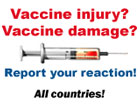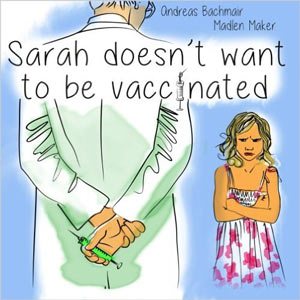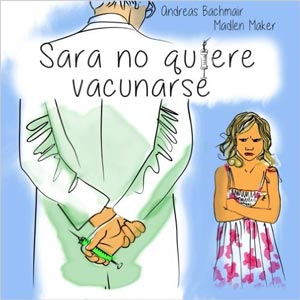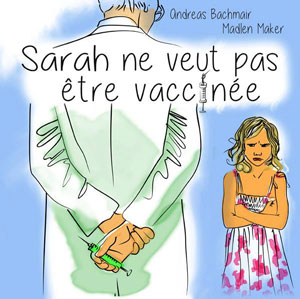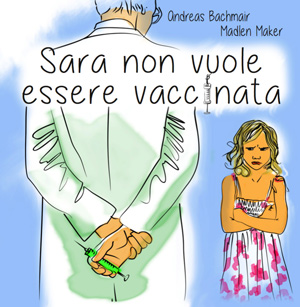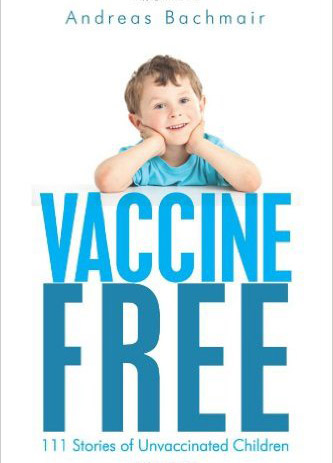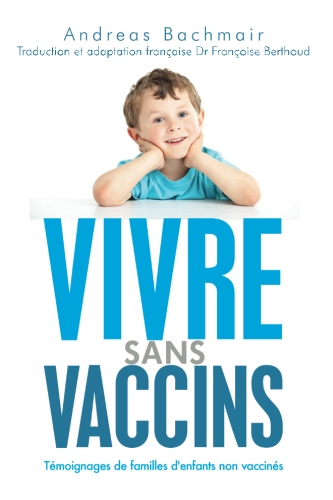Vaccines: Virus, bacteria, toxins and additives
In addition to bacteria, viruses (weakened or killed) or toxins, vaccines today contain a variety of other unnatural additives. For the breeding of pathogens cultures of embryonic chicken cells, formerly organs of animals (monkeys, mice, guinea pigs, horses ...) and human cancer cells are now being used! These cells are known asHeLa cells, and are in particularly problematic, since the transfer of information from the cancer cells to a healthy human body can be the endresult. Thus, one could sometimes observe a tissue degeneration within the injection area. A causal relationship can not be excluded here.
Todays vaccines are also increasingly genetically produced. Long-term studies on the safety of the substances are not available at present and most likely, also in the foreseeable future, no long-term exsisting studies will be promoted in regards to conventional vaccines.
In vaccines, protein components can always remain (ex: from chicken eggs), which entail an allergic potential in itself. Normally, proteins are completely harmless, if they are absorbed through the digestive tract. However when they are injected into the skin or muscle, it can cause or prompt an allergic immune response. In severe cases, can lead to anaphylactic reactions including but not limited to shock.
Additives
In order to preserve the vaccines, chemicals, some toxic substances are added: Aluminum hydroxide and phosphate (as a binder and effect Amplifier
Formalaldehyd, chloroform, polysorbate 80(to inhibit the pathogen multiplication) Antibiotics, thiomersal (against bacterial contamination of the vaccine)
With each vaccination, a large number of chemical substances are introduced into the body. The problem is mainly the thiomersal. This is a mercury-containing compound that is extremely toxic when it enters the bloodstream. With one vaccine, one reaches 30% of the mercury limit (of an adult). In children or infants whom have a much lower body weight, this limit is exceeded.
Today thiomersal has been removed from most vaccines, due to significant side effects. It is found only in a yet few vaccines.
Mercury (thiomersal)
Mercury in the form of thiomersal (ethyl mercury liquid vaccines- Thiosalicylat) may be present, a biocide is added to the vaccine as a preservative. To 54% of its molecular weight is composed of mercury.
Symptoms of acute mercury poisoning may include:
Irritation to mucous membranes and skin, Paresthesia of the mouth, lips, tongue, hands and feet, lack of concentration, disinterestedness,weakness
Apathy, extreme tiredness, swallowing and articulation problems, concentric narrowing of the field, deafness, aggressive outbursts, with periods of depression, incoordination in the movement,memory disorders.
Added to chronic poisoning:
Speech, Malaise, disruption of nerve-muscle transmission and motor coordination, restricted vision, muscular dystrophy.
Autism and mercury (thiomersal)
In a study by Mark Geier, president of the Genetic Center of America, which examined the relationship of mercury-containing vaccines and the onset of neurological disorders, particularly autism and heart disease it was significantly shown:
1. Children in the U.S. receive up to 150 times more mercury through oral vaccinations, recieving more than maximum allowed limit!
2. The higher the exposure to mercury, the higher the risk for neurological or cardiac disease.
3. The authors combine the high mercury levels, with the highnumbers in morbidity rates of autism, speech disorders and heart disease.
The authors insist that by removing mercury from vaccines, a further increase of neurological disorders in children,as autism, Asperger's syndrome, etc. can be halted. Meanwhile, although thiomersal was removed from many vaccines, the influenza vaccination has been since 2004 recommended to all children in the U.S. This is not all being produced by thiomersalfree manufactures!
Professor George Graham of the University of Saskatchewan in Saskatoon, Canada, has long studied how mercury behaves in the body. This depends on many factors, such as molecular shape and as the presence of selenium in the body. Prof George says that although his results are preliminary, they show in rodent experiments that (within a short time of an one hour) "thiomersal accumulates in the brain". He did not have very much more to say because the study has yet been published. However it shocked him, when he found out that thiomersal levels still have their place in vaccines. Thiomersal would be the last ingediant, which one should place into a vaccine, as his words discribed it
Today, mercury or thiomersal would never get an official approval for use in medicines anylonger.It is still being used based on the fact, is that it is simply always been used for over 70 years. Prof. George himself made sure that during her pregnancy of his wife, under no circumstances would get a flu vaccine, for pregnant women whom receive a flu vaccination recieve a large amount of thiomersal and we know pretty much where that thiomersal accumulates: in the BRAIN or the kidney of the fetus. He himself would not be surprised if there was a connection between autism and mercury. (Scientists applaud move away from use of mercury, by Roger Highfield, Science Editor, The Telegraph, UK, August 10, 2004)
An interesting study by Bradstreet was able to demonstrate evidence of the causal link between thiomersal and MMR vaccination and neurodevelopmental disorders. The data base continues to be, although with preliminary results, sufficient evidence for the overlapping of populations with MTHFR SNP and cysteine deficiency, with elevated mercury levels, and with the measles virus persistence. It is also likely that defects are in the methionine Transsulfurations path, possibly being the link between the observations on thiomersal and MMR.
Aluminum hydroxide, aluminum phosphate, aluminum sulfate
Aluminum can cause neurological, skeletal and hematological toxic symptoms. (Zhu H, Webb M, Buckley J & Roberts NB:
Different Mg to Fe ratios in the mixed metal MgFe hydroxy-carbonate compounds and the effect on phosphate binding compared with established phosphate binders.J Pharm Sci 91(1): 53-66, 2002).
In children who have received large doses of aluminum hydroxide via therapy for hyperphosphatemia, in connection with azotemia, and during treatment with hemodialysis, this has been described as an aluminum intoxication. The symptoms of severe osteomalacia and aluminum intoxication include large aluminum deposits at the transitions from not calcified to calified bones. (McEvoy GK: AHFS Drug Information.American Society of Hospital Pharmacists Inc, Bethesda (USA); 2363 pp, 1992).
It is by now well known that aluminum compounds can lead to the so-called macrophage-Myofaszitis, (Myogelose) a muscle disease. This results due to inflammation of the muscle around the injection area. ( Rivas E, Gomez-Arnaiz M, Ricoy JR, Mateos F, Simon R, Garcia-Penas JJ, Garcia-Silva MT, Martin E, Vazquez M, Ferreiro A, Cabello A.Macrophagic myofasciitis in childhood: a controversial entity.Pediatr Neurol. 2005 Nov;33(5):350-6., Heidary N, Cohen DE.Hypersensitivity reactions to vaccine components.Dermatitis. 2005 Sep;16(3):115-20.,Shingde M, Hughes J, Boadle R, Wills EJ, Pamphlett R.University of Sydney, Sydney, NSW. Macrophagic myofasciitis associated with vaccine-derived aluminium. Med J Aust. 2005 Aug 1;183(3):145-6. )
In a new study, the authors report Petrik et al. (still in the peer-review process, not yet published) on the effects of Aluminiumadjuvants to motor neurons in mice. The starting point of the investigation is the suspicion that the Gulf War Syndrome may be caused by the anthrax vaccination.
Pathogenetically it is the direct toxicity of aluminum, but also the indirect toxicity might be responsible through induction of the autoimmune phenomena by TH1/TH2-Dysbalance. The authors also write in their study, that the use of aluminum compounds in vaccines (ex: hepatitis A and B, diphtheria, pertussis, and tetanus) could lead to extensive neurological consequences. Without long-term studies, the safety of these substances simply can not be proven, and persons whom are now being vaccinated with aluminum compounds, could have the risk of developing neurological complications.
The following list contains the amount of Aluminum in different US vaccines:
| Vaccine | Aluminum |
| ActHib | 0mcg |
| PedVaxHib | 225 mcg |
| Prevenar 13 | 125 mcg |
| Prevnar | 125 mcg |
| Daptacel (DTaP) | 330 mcg |
| Tripedia (DTaP) | 170 mcg |
| Infanrix (DTaP) | 625 mcg |
| Recombivax (HepB) | 250 mcg |
| Engerix B (HepB) | 250 mcg |
| Polio | 0 mcg |
| MMR | 0 mcg |
| Chickenpox | 0 mcg |
| Hep A | 250 mcg |
| Comvax (hep B,HIB) | 225 mcg |
| Pentacel (DTaP,, HIB, polio) | 1500 mcg |
| Pediarix (DTaP, hepB, polio) | 850 mcg |
| Pediacel (DTaP/IPV/Hib) | 330 mcg |
| TriHIBit (DTaP,HIB) | 170 mcg |
| Neis Vac-C | 500 mcg |
| Menjugate | 400 mcg |
| Meningitec | 125 mcg |
| Gardasil (HPV) | 225 mcg |
| Cervarix (HPV) | 500 mcg |
| Revaxis | 350 mcg |
| Repevax | 330 mcg |
The maximum safe level for aluminum intake (injected feeding solutions) is 5 mcg/kg/day (A.S.P.E.N., the American Society for Parenteral and Enteral Nutrition). The FDA maximum threshold for aluminum received in IV feeding solutions is 25 mcg per day. Vaccines, for some reason, are not required to have this label and also are not required to follow the maximum dosage of 25 mcg.
Antibiotics
The uncritical and massive use of antibiotics to fight disease by some physicians is now controversial in Germany. The short-term effectiveness of antibiotics is beyond question and is lifesaving in many cases. But besides the relative well-studied above noted serious problem of resistance are also the side effects become a problem: Antibiotics not only destroy certain disease-causing germs, but also simutaniously more than 300 co-existing types of bacteria in the intestinal immune system, these are essential and whilst these being killed, allows for example, among other things, the candida yeast infection to grow and spread. The outweighing of different types of bacteria in the intestine shows bacteria that have previously identified themselves only as a few percent, becoming by far more common. Such a diversion can be compensated by a focused change in dietary habits and limited naturopathic resources. It takes time to get back into balance.Vaginal fungal infections can also occur during or after an antibiotic treatment, since the protective (Döderlein vaginal flora) can be destroyed. It is to be brought into connection with the disruption of the immune system and the dierect development of allergies, this can also occur as a side effect of antibiotics.
The long-term effects of the use of antibiotics, have yet been very well investigated. The endosymbiotic theory of the American biologist Lynn Margulis points out: that the human cell biologie could be a evolutionary-biological result of the cooperation between different bacterial species. Largely ignored is that antibiotics could very well also cause damage to human cells. The controversial biologist Stefan Lanka stated in April 1998 at an Annual Meeting of the pharmaceutical company Bayer AG brought forth attention to potential hazards of antibiotics, such as Bayer-Ciprobay to the human DNA, he noted that other antibiotics and chemotherapeutic agents are under suspicion and may be intervening in the DNA of good bacteria thus prevents their multiplication.Possible damage to the mitochondria, says Lanka, would be passed through the ovum of the mother to the child. In-depth research on this has not been officially completed.
Up to date, the suspicion has not been rebutted that there may be a correlation between the onset of antibiotic use and the wide-surface exponential rise of chronic diseases related to severe degenerative diseases of the central nervous system (Parkinson's, multiple sclerosis, Alzheimer's, etc.) in precisely those countries and in correspondence to the frequent use of antibiotics. The rise of these diseases can also be brought into correlation with the increase of the life expectancy of the population, however, the fact that in nations with relatively high life expectancy that have now been faced with antibiotics, we are seeing a massive increase in central nervous system diseases.
For these reasons, the use of antibiotics in the opinion of the antibiotic critics, "should be used as the very last resort" in a life threatening or medical emergency.
Recorded sources of drugs and drug residues in the environment
Medicines, and thus also antibiotics, due to high biological active substances may cause damage in the environment, in concentrationed levels they damage corresponding metabolites (Metabolism). Due to improved techniques in analysis since the mid-1990s, more evidence of drugs and their residues can be found in surface water, groundwater and drinking water. Over the past 50 years there have been a total of approx. one million tons of various antibiotics released into the biosphere.
Entry sources into the environment, in addition to excreta (urine, feces) of humans and animals have also been known to be thrown away unused medicines/drugs.
There are valid fears that due to the presence of medicines/drugs that their residues in the environment can bring forth a light resistance of bacteria to antibiotics.( http://de.wikipedia.org/wiki/Antibiotika)
Formaldehyde
Through the distinct biological reactivity of formaldehyde, it in high concentration causes irritation of the mucous membranes, may may cause allergies upon contact with skin. It is under reasonable suspicion to possess cancer potential, to contribute to physical or chemical changes of the genetic material of the human body as well as contribute to birth defects.
The damaging effects already begin well below the odor threshold. In many cases, the typical odor is also covered by other components in cigarette smoke and car exhaust are amoung others included. F. is listed in the MAC list in Section III-B "materials with a reasonable suspicion of carcinogenic potential".
Formaldehyde even in short-term exposure, even at low concentrations cause irritation to the eyes and respiratory system: from 0.01 ppm irritation of the eyes, from 0.08 ppm irritation of the eyes and nose, and throat irritation as 0.5 ppm.Concentrated vapors of Formaldehyde greater than 10 ppm can cause serious irritation of the mucous membranes leading to tearing, coughing and a burning sensation in the nose and throat. Concentrations over 30 ppm cause toxic pulmonary edema and pneumonia, there is then serious danger to life.
Chronic effects are mood disorders such as insomnia, fatigue, loss of drive, lack of appetite or nervousness, eye irritation and conjunctivitis, skin irritation, chronic cough, colds and bronchitis, headaches, depression, etc.
Furthure excipients used as a carrier
Many vaccines also entail certain oils, such as Squalene (MF 59) or adjuvant Bayol F and immunostimulatory factor used. Although the exact Pharmacodynamics in regards to reaction of these substances in humans are unknown, they have been used for many years. In animal experiments, these substances led to autoimmune reactions. (Yoshiki Kurodaa, Dina C. Nacionalesa, Jun Akaogia, Westley H. Reevesa and Minoru Satoh Autoimmunity induced by adjuvant hydrocarbon oil components of vaccine, Biomedecine & Pharmacotherapy Volume 58, Issue 5 , June 2004, Pages 325-337)


